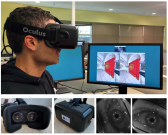Perceptually-Based Foveated Virtual Reality

Humans have two distinct vision systems: foveal and peripheral vision. Foveal vision is sharp and detailed, while peripheral vision lacks fidelity. The difference in characteristics of the two systems enable recently popular foveated rendering systems, which seek to increase rendering performance by lowering image quality in the periphery. We present a set of perceptually-based methods for improving foveated rendering running on a prototype virtual reality headset with an integrated eye tracker. Foveated rendering has previously been demonstrated in conventional displays, but has recently become an especially attractive prospect in virtual reality (VR) and augmented reality (AR) display settings with a large field-of-view (FOV) and high frame rate requirements. Investigating prior work on foveated rendering, we find that some previous quality-reduction techniques can create objectionable artifacts like temporal instability and contrast loss. Our emerging technologies installation demonstrates these techniques running live in a head-mounted display and we will compare them against our new perceptually-based foveated techniques. Our new foveation techniques enable significant reduction in rendering cost but have no discernible difference in visual quality. We show how such techniques can fulfill these requirements with potentially large reductions in rendering cost.
Publication Date
Published in
Research Area
Uploaded Files
Copyright
Copyright by the Association for Computing Machinery, Inc. Permission to make digital or hard copies of part or all of this work for personal or classroom use is granted without fee provided that copies are not made or distributed for profit or commercial advantage and that copies bear this notice and the full citation on the first page. Copyrights for components of this work owned by others than ACM must be honored. Abstracting with credit is permitted. To copy otherwise, to republish, to post on servers, or to redistribute to lists, requires prior specific permission and/or a fee. Request permissions from Publications Dept, ACM Inc., fax +1 (212) 869-0481, or permissions@acm.org. The definitive version of this paper can be found at ACM's Digital Library http://www.acm.org/dl/.
